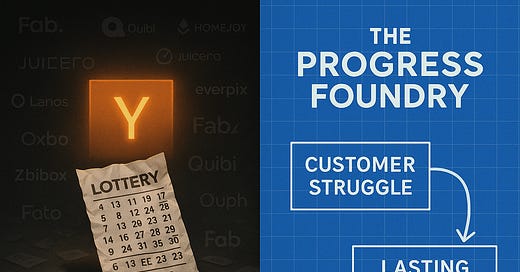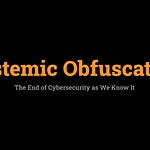Introduction: The Allure and the Flaw of the YC Model
For over a decade, the Silicon Valley dream has had a single, unmistakable gateway: Y Combinator. It’s the institution that minted giants like Airbnb, Stripe, and Dropbox. Its mantra, "Make Something People Want," has become a sacred text for aspiring founders worldwide. The allure is undeniable—a potent mix of capital, mentorship, and a network that can turn a garage project into a global phenomenon. YC has positioned itself as the premier system for building successful companies.
But what if that system is fundamentally flawed?
What if the billion-dollar valuations and celebratory headlines obscure a darker, more volatile reality? A reality where the model's success relies not on a repeatable process, but on the statistical inevitability of a lottery. A system where, for the vast majority of founders, the outcome isn't a triumphant IPO, but a quiet, capital-draining fade to black.
This isn't an attack on YC's success, but a critical examination of its method. I'm going to show you that the very foundation of the modern accelerator model is cracked. The "move fast and break things" ethos, coupled with a vague directive to "make something people want," is an incredibly inefficient and often heartbreaking way to innovate.
More importantly, I'm going to propose a better way. A new model, grounded in the rigorous, customer-centric framework of Jobs-to-be-Done (JTBD). A model that shifts the focus from hunting mythical unicorns to systematically building valuable, sustainable companies. We’ll explore how by deeply understanding customer struggle—not just their stated wants—we can de-risk innovation, build solutions that truly matter, and create a more reliable engine for both founder success and investor returns.
Welcome to "The Progress Foundry."
The Y Combinator Paradox: Why "Make Something People Want" Isn't Enough
To understand the need for a new model, we first have to dissect the old one. The YC model, and the accelerator culture it spawned, is built on a few core principles that, under scrutiny, reveal themselves to be less like a blueprint and more like a bet.
The Tyranny of the Power Law
The most celebrated feature of the YC portfolio is also its most revealing flaw: its success is dictated by a brutal power-law distribution. A tiny handful of portfolio companies—the .01%—generate the overwhelming majority of the returns. Companies like Stripe and Airbnb are so colossally successful that they cover the losses of thousands of other investments and still produce incredible returns for YC's partners.
This isn't a sign of a brilliant system for making companies successful; it's the sign of a brilliant strategy for capturing outliers. YC is not a factory that reliably produces successful startups. It is a highly effective, wide-mouthed funnel that is exceptionally good at finding and catching the few startups that were already on a trajectory for massive success. For the investor, this model works. For the ecosystem and the other 99% of founders, it's a high-stakes lottery.
This reliance on outliers creates a perverse incentive structure. The goal ceases to be "help every company succeed" and becomes "find the one company that can return the entire fund." This pressure forces founders to chase hyper-growth at all costs, often by tacking on features, bloating their products, and pursuing markets they don't understand, rather than methodically solving a core problem.
"Make Something People Want": A Vague and Unreliable Compass
On the surface, it’s the most obvious advice in business. Of course you should make something people want. Who would argue otherwise? But as a tool for innovation, it's dangerously imprecise.
The problem is that "want" is fickle, hard to define, and often a poor predictor of behavior. How many of us want to eat healthier, exercise more, or learn a new language? How many of us actually do it? Customers can't reliably tell you what they will buy, because they often don't know themselves. Asking them what they "want" leads to feature wish-lists and incremental improvements, not breakthrough innovations.
This vague guidance encourages a "ready, fire, aim" approach. Build a Minimum Viable Product (MVP), launch it, and see what sticks. This isn't strategy; it's throwing spaghetti at the wall. It leads to a colossal waste of time, money, and emotional energy as founders pivot endlessly, searching for a problem to fit their solution.
The core issue is that "want" is a solution-centric metric. It focuses on the product. A far more powerful lens is to focus on the customer's struggle. What progress is the customer trying to make in their life? What obstacles are getting in the way? This is the essence of Jobs-to-be-Done. Although, you’ll rarely see me rely on these vague terms either!
The Median Outcome: A Story Rarely Told
For every celebratory TechCrunch article about a YC company's massive fundraise, there are hundreds of untold stories of failure. The data suggests that the median outcome for a YC-backed company is not a small acquisition or a sustainable lifestyle business—it's shutting down.
The model is optimized for the home run, not for the base hit. Companies that could be profitable, sustainable businesses are often pushed to pursue a venture scale that doesn't fit their market, ultimately leading them to burn out. YC's brand and network are undeniably powerful, but they can't create a market where one doesn't exist. They can't manufacture a real customer struggle.
This is the Y Combinator Paradox: the most prestigious startup program in the world is, for most of its participants, a beautiful, well-marketed, and expensive path to failure. It's time for a model that changes the odds.
A Better Way: The Jobs-to-be-Done (JTBD) Approach to Venture Creation
If the old model is a lottery, the new model must be a science. Jobs-to-be-Done isn't a new idea—it was pioneered by visionaries like Clayton Christensen and Tony Ulwick—but its application to venture creation is the radical shift we need.
The core principle is simple: customers don't buy products; they "hire" them to get a job done. I don't buy a drill because I want a drill. I buy a drill because I want to make a quarter-inch hole in my wall. The drill is the solution I hire to get the "job" of "creating a hole" done.
This simple reframing changes everything.
From Ideas to Problems
The YC model starts with an idea and a founder. “I have an idea for a social network for pet owners.” The founder then spends months trying to validate that idea.
The JTBD model starts with a struggle. It asks, “When are pet owners struggling? How are their current solutions failing them?” Maybe the job is "ensure my pet is happy and healthy while I'm away on a business trip." The current solutions—asking a neighbor, using a traditional kennel—are full of anxieties and compromises. This is a rich, fertile ground for innovation.
By starting with the problem, you de-risk the entire venture from day one. You're no longer guessing if people want your solution; you're anchoring your work in a proven, existing struggle.
From Demographics to Contexts
Traditional marketing tells you to focus on demographics: "25-35-year-old urban professional women." This is a nearly useless lens for innovation. Does every 30-year-old woman in a city have the same needs? Of course not.
JTBD focuses on context. The situation is what creates differentiated segments in the Job-to-be-Done. A busy executive trying to grab a quick, healthy lunch between meetings has a very different "job" than that same executive planning a leisurely weekend dinner with her family. The context defines the struggle and the desired outcomes. By understanding the context, you can design a solution that is perfectly tailored to the job, making it far more likely to be "hired."
From Features to Progress
Founders, especially technical ones, love features. They build more, add more, and create complexity, hoping that one of those features will be the magic bullet.
The JTBD framework forces you to ask a different question: "Does this feature focus on an underserved desired outcome that helps the customer get the job - or a step - done better or more effectively, efficiently, or conventiently?" If the answer is no, the feature is waste.
This leads to a powerful concept: elevating the level of abstraction. Often, the most disruptive innovations don't add more features; they achieve the same outcome with fewer visible steps and components. Think about how Uber or Lyft got the job of "getting from point A to point B" done. They didn't invent a better car; they built a system that eliminated the struggles of the old way: hailing a cab, wondering about the route, fumbling for cash. They abstracted away the friction. A truly novel solution often has fewer visible features because it has integrated multiple steps of the job into a seamless whole.
Introducing "The Progress Foundry": A Novel Venture Model
If we take these JTBD principles and use them to design a venture creation process from the ground up, what does it look like? It looks like a system designed not to find outliers, but to create value systematically. I call it "The Progress Foundry."
The Foundry is built to get a very specific job done.
The Core Job of the Founder
A founder doesn't just want to "build a company." They are hiring an incubator or an investor to help them get a job done: "Transform a nascent concept into a capital-efficient, market-ready business that solves a real customer problem."
The Progress Foundry is designed to get this job done better than any existing alternative by breaking the journey into three distinct phases.
Phase 1: De-risking the Problem
What it is: This is a 6-8 week, intensive research phase that happens before a single line of code is written. Instead of an MVP (Minimum Viable Product), the goal is a Minimum Viable Problem (MVP).
How it works: Founders are not paired with generic "mentors," but with JTBD research practitioners. They learn how to conduct deep customer interviews to uncover the underlying Job-to-be-Done (most of them are now using my generative AI prompts instead). They map out every step of how customers are currently getting the job done and, crucially, identify where they struggle the most.
The Output: The deliverable isn't a pitch deck; it's a "Job Map" and an "Opportunity Landscape." This is a quantitative and qualitative breakdown of the customer's job, highlighting the top 5-10 underserved outcomes. These are the specific, measurable metrics of success from the customer's point of view (e.g., "minimize the time it takes to get a reliable answer to a question," "reduce the likelihood of making a costly error").
The Investment: The Foundry makes a small, initial investment to fund this research phase. This "problem-first funding" is revolutionary. It's a bet on understanding the market deeply before committing millions to a solution.
See my artical on Real Options for more details 👇
Phase 2: Co-creating the Solution
What it is: Once a high-value, underserved problem has been rigorously validated in Phase 1, the venture moves to the solution phase.
How it works: Now, the founder is paired with product designers and engineers who are also fluent in JTBD. The team uses the Opportunity Landscape (and all of the supporting ranking data) from Phase 1 as their blueprint. The goal is to design a solution concept that outperforms the existing solutions on the most important, underserved outcomes. This is where the "Creativity Triggers" come in—systematic prompts to challenge assumptions and explore novel ways to get the job done. This is where we focus on elevating the level of abstraction.
Example of Abstraction: The job is "Ensure my house is clean and tidy for unexpected guests."
Old Solution: A chaotic collection of tools. You need a vacuum, mop, various cleaning sprays, cloths, calendar reminders to clean, and the time to do it all. Many steps, lots of friction.
Elevated Solution: A subscription service. You press a button on an app. A vetted, trusted cleaner shows up at a scheduled time with their own supplies and gets the job done to a predefined standard. The job is done better, with a fraction of the visible features and effort from the user.
The Output: A "Solution Blueprint." This is a high-fidelity prototype and a business case showing how the proposed solution will get the job done significantly better and/or cheaper. This blueprint, backed by the data from Phase 1, is what's used to raise a proper seed round.
Phase 3: Scaling the Impact
What it is: This is the growth and acceleration phase, but with a critical difference.
How it works: All marketing, sales, and product development are anchored to the Job-to-be-Done.
Marketing: The messaging doesn't lead with features ("We have a 5-blade razor!"). It leads with the customer's struggle and the promised land ("Tired of razor burn and expensive cartridges? Get a perfect shave, delivered.").
Sales: The sales team is trained to diagnose the customer's JTBD. Are they the right fit? What struggles are they facing? The product is positioned as the solution to their specific progress.
Product: The roadmap is prioritized based on what will help customers get the job done even better. New features are only added if they address a known, underserved outcome.
The Output: A sustainable, capital-efficient business with a clear value proposition, a fanatical customer base, and a scalable growth engine. It might become a unicorn, but it doesn't have to. It's built to last.
Novel Concepts in Action: How The Progress Foundry Gets the Job Done Better
The Progress Foundry isn't just a theoretical idea; it's a practical system built on novel approaches to venture creation. Here’s how its key concepts map to proven creativity principles.
Conclusion: Building a Future of Sustainable Innovation
The Y Combinator model has had its moment. It proved that concentrating talent and capital could create immense value. But it did so with a model that is wasteful, stressful, and, for the majority of its participants, ineffective. Its reliance on the power-law lottery is a feature, not a bug—and it's a bug for the innovation ecosystem as a whole.
We can do better.
The Progress Foundry, and the Jobs-to-be-Done philosophy that underpins it, offers a path to a more deliberate, more focused, and more humane way of building companies. It’s a model that respects the founder's time, the investor's capital, and, most importantly, the customer's struggle. It replaces the frantic search for ideas with the disciplined search for problems. It trades the vague hope of "making something people want" for the concrete strategy of helping people make progress.
This approach won't guarantee that every startup becomes a unicorn. Nothing can. But it will dramatically increase the odds of building companies that are valuable, durable, and truly innovative. It will create more base hits, more doubles, and more triples—and in doing so, will likely produce just as many, if not more, home runs as a byproduct of building fundamentally sound businesses.
It’s time to stop hunting for unicorns and start building for progress.
What do you think?
I’ve laid out a deep critique and a comprehensive alternative to the dominant venture model.
Do you agree that the "Make Something People Want" mantra is broken?
What are the biggest challenges you see in implementing a JTBD-focused model like The Progress Foundry?
Leave a comment below. I'd love to hear your thoughts.
Follow me on 𝕏: https://x.com/mikeboysen
If you'd like to see how I apply a higher level of abstraction to the front-end of innovation, please reach out. My availability is limited.
Mike Boysen - www.pjtbd.com
Why fail fast when you can succeed the first time?
📆 Book an appointment: https://pjtbd.com/book-mike
Join our community: https://pjtbd.com/join

















Share this post